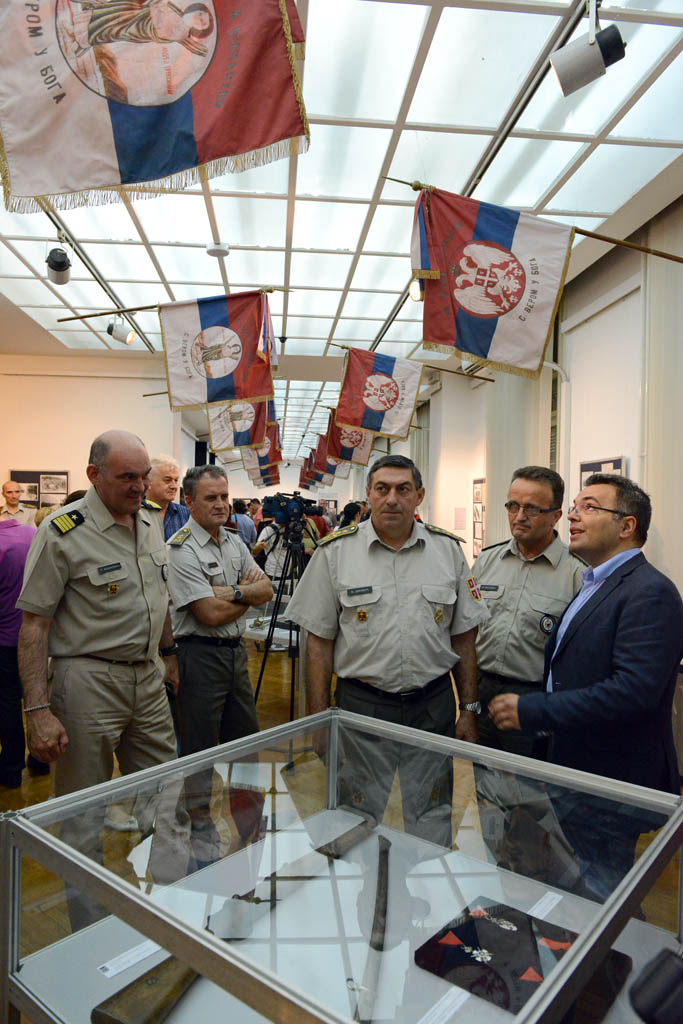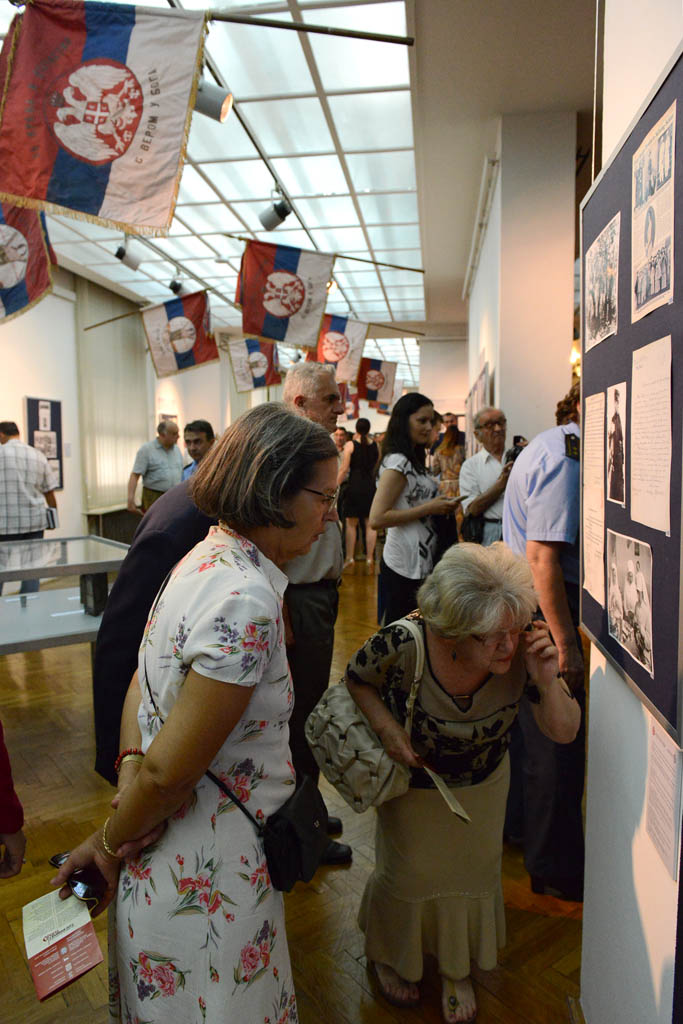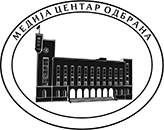02.07.2014
The exhibition "Serbia in the Great War" opened at the Central Military Club
 - Today’s exhibition is of about 60 manifestations in which the Ministry of Defence and the Armed Forces of Serbia mark the centenary of the beginning of the First World War, proudly preserving our ancestors’ deeds from being forgotten – Defence Ministry Secretary of State Zoran Djordjevic stated today, at the opening of the exhibition “Serbia in the Great War” at the Grand Gallery of the Central Military Club of the Armed Forces of Serbia.
- Today’s exhibition is of about 60 manifestations in which the Ministry of Defence and the Armed Forces of Serbia mark the centenary of the beginning of the First World War, proudly preserving our ancestors’ deeds from being forgotten – Defence Ministry Secretary of State Zoran Djordjevic stated today, at the opening of the exhibition “Serbia in the Great War” at the Grand Gallery of the Central Military Club of the Armed Forces of Serbia.According to him, the archive documents, photographs and museum items from the period of the Great War that are exhibited remind us of causes, leaders and victims of that war, following the chronologically most significant events that had determined the course of further history.
- With its authentic meaning, this exhibition affirms facts and brings light to events of that time the way the truth dictates. Faced with such facts, any attempt at review remains mute. Today, we are here to bow to our ancestors and show the world that we have not forgotten who they were – Djordjevic said, adding that the exhibition has been opened four our sake, but also for the sake of our ancestors, to whom it is dedicated.
 Speeches about the exhibition were also given by: Colonel Petar Boskovic, Head of the Public Relations Department at the Ministry of Defence, Jasminka Nikolic, PhD, Director of the Historical Archive Pozarevac, Colonel Milorad Sekulovic, Director of the Military Archive and Miomir Ilic, Mayor of Pozarevac.
Speeches about the exhibition were also given by: Colonel Petar Boskovic, Head of the Public Relations Department at the Ministry of Defence, Jasminka Nikolic, PhD, Director of the Historical Archive Pozarevac, Colonel Milorad Sekulovic, Director of the Military Archive and Miomir Ilic, Mayor of Pozarevac.Colonel Boskovic stressed that, seen from a right archive and museum point of view, rounds off the subject that has been of great significance this year as well for the Ministry of Defence and the Armed Forces of Serbia, but also for our people and history.
- Preparations for marking of the centenary of the beginning of the Great War have started much earlier for members of the Ministry of Defence, Armed Forces of Serbia, Public Relations Department and Odbrana Media Center. On the occasion of marking 40 years of death of Milunka Savic, our heroine and most honored woman during the First World War, an exhibition of her photographs, medals and documents was held at this same place last year. Recently, an exhibition about the legendary Iron Regimen from Toplice was also held. The Ministry of Defence and the Armed Forces of Serbia provided selfless help to RTS in making of a film about Milunka Savic, and the Military Film Center “Zastava Film” is still working intensely on making two more documentary films about the theme of the WWI. Considering that this is a marking of a significant date in our entire, primarily military history, Odbrana Media Center dedicated seven of its issues to this subject. There have also been numerous performance of the Art Ensemble of the Ministry of Defence “Stanislav Binicki”, exhibition setups at the Odbrana Media Center, and other cultural events dedicated to WWI, which are, like today’s exhibition, paying the debt of today’s generations to their ancestors – Colonel Boskovic said.
 According to Jasmina Nikolic, a new wave of interest for the subject of the WWI has broken out in the year of marking the jubilee.
According to Jasmina Nikolic, a new wave of interest for the subject of the WWI has broken out in the year of marking the jubilee.- The group of authors dealing with the war’s anthropology, military or local history, had a humble intention to once again draw attention to the devastating influence of political review of history through affirmation of archive documents on Serbia during WWI. Convinced that the nations who know their history have a future, the authors gave the public a short history of the Great War and positions of Serbia and Branicevo in that international clash. The objective was to offer a unique story about wartime events in Serbia then, and their reflection on a smaller environment – Branicevo, by using visualization of wartime events through the presentation of, so far lesser known archive photographs and documents – Director of the Historical Archive Pozarevac said.
 Colonel Milan Sekulovic said that visitors can see a result of joint projects of the aforementioned institutions, and that it pays respect to the Serbian Military for their heroic actions in preserving the Serbian state. He added that the exhibition is an opportunity to perceive the wartime period with a time distance, necessary for the science of history, and to extend knowledge on the war’s influence on all segments of Serbian society.
Colonel Milan Sekulovic said that visitors can see a result of joint projects of the aforementioned institutions, and that it pays respect to the Serbian Military for their heroic actions in preserving the Serbian state. He added that the exhibition is an opportunity to perceive the wartime period with a time distance, necessary for the science of history, and to extend knowledge on the war’s influence on all segments of Serbian society.Mayor of Pozarevac stressed that, with today’s exhibition, the Historical Archive Pozarevac gave another look at the past times that had left deep marks in people’s lives, and added that the exhibition contributes to understanding the greatness of national history and the dedication of citizens of Pozarevac who had given their lives for their descendants.
The opening of the exhibition was also attended by General Ljubisa Dikovic, Head of the General Staff of the Armed Forces of Serbia, representatives of the Ministry of Defence and the Armed Forces of Serbia, and many visitors and art enthusiasts.
 The exhibition is divided into 18 thematic-chronological parts with 270 selected archive documents and photographs that contribute to better understanding of the processed topics and offer new views on the Great War 1914-1918. The part referring to Branicevo and the Northeastern Serbia contains a detailed review of events on this significant territory of the Kingdom of Serbia in the period 1915-1918, which is also a characteristic history of life under occupation. This exhibition of archive documents is enriched with museum items from the Military Museum collections.
The exhibition is divided into 18 thematic-chronological parts with 270 selected archive documents and photographs that contribute to better understanding of the processed topics and offer new views on the Great War 1914-1918. The part referring to Branicevo and the Northeastern Serbia contains a detailed review of events on this significant territory of the Kingdom of Serbia in the period 1915-1918, which is also a characteristic history of life under occupation. This exhibition of archive documents is enriched with museum items from the Military Museum collections.The base structure of the exhibition of the following catalogue consists of the subjects: the beginning of WWI and operations of the Serbian Military in 1914, Serbia and its Military in late 1915, Allies and Serbia 1914-1916, rehabilitation and reorganization of the Military of the Serbian Kingdom on Corfu, Allie medical missions and healthcare provided to the Serbian Military, Serbian Military on the Salonika front 1916-1917, and chapters about heroines of WWI, volunteers in the Serbian Military and their arrival to the Salonika front, and others.
The exhibition and catalogue were created by a group of authors who are specialists in war history and anthropology, military or local history – Jasmina Zivkovic and Dragana Miloradovic from the Historical Archive Pozarevac, Marijana Mraovic from the Military Archive, Bojan Dimitrijevic, PhD, from the Serbian Contemporary History Institute, and associates: Jasmina Nikolic, PhD, Danilo Sarenac, PhD, Miroljub Manojlovic, PhD, Gordan Bojkovic, PhD and Nebojsa Djokic.
 Curators of the Military Museum Dusanka Maricic, Andjelija Radovic, Vuk Obradovic and Bojana Ilic selected items for the museology part of the exhibition. Convinced that the nations who know their history have a future, the authors gave the public a short history of the Great War and positions of Serbia and Branicevo in that international clash.
Curators of the Military Museum Dusanka Maricic, Andjelija Radovic, Vuk Obradovic and Bojana Ilic selected items for the museology part of the exhibition. Convinced that the nations who know their history have a future, the authors gave the public a short history of the Great War and positions of Serbia and Branicevo in that international clash. The exhibition will be open until July 26, 2014.
 PHOTOGALLERY
PHOTOGALLERY
